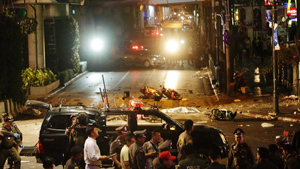Bangkok, Aug 17: Two powerful bomb blasts outside a hugely popular Brahma temple in a crowded business district here today killed at least 27 people, including four foreigners.
The twin blasts, which the government believed was aimed at damaging economy and tourism, occurred in a space of minutes around 7 pm (5:30 IST) outside Erawan Shrine dedicated to Lord Brahma in the downtown Chidlom district, creating panic as people fled the place that was spilled with blood.
 The temple is located on a main road through Bangkok's commercial hub and is surrounded by three major shopping malls. However, there were no reports of any Indian casualties in the explosions that caused a huge amount of chaos, with body parts scattered everywhere. It is among Bangkok's most popular tourist attractions.
The temple is located on a main road through Bangkok's commercial hub and is surrounded by three major shopping malls. However, there were no reports of any Indian casualties in the explosions that caused a huge amount of chaos, with body parts scattered everywhere. It is among Bangkok's most popular tourist attractions.
Police said first an improvised explosive device fastened to a utility pole in front of the temple at the Ratchaprasong intersection detonated which was immediately followed by a motorbike bomb blast, causing two nearby taxis to explode.
However, some sources said a bomb was hidden under a roadside bench in front of the Phra Prom (Brahma temple). No group has claimed responsibility for the blast.
The Rajprasong intersection has been the centre of political demonstrations in recent years.
Thai TV said at least 27 people were killed and 80 others injured during the evening rush hour. The nationality of four foreigners killed in the blast is not known yet.
The iron fence surrounding the shrine was bent outward by the force of the blast.
Defence Minister Prawit Wongsuwong said: "It was a TNT bomb... the people who did it targeted foreigners and to damage tourism and the economy."
Police said the bomb was made of 5 kg of TNT explosive. The explosion had a radius of 40 metres.
The Bangkok Post quoted police as saying that at least one more bomb was defused by officers in the same area.
"We are in close touch with the authorities concerned. So far there have been no reports of any Indians being injured," Indian Ambassador to Thailand Harsh Vardhan Shringla told PTI.
Police, emergency vans and bomb detonation squads rushed to the area where several motorcycles lay mangled. Bomb attacks in Bangkok are extremely rare.
In 2012, a series of explosions hit Bangkok, injuring five people. Thai authorities said that the bombings were a botched attempt by Iranian nationals to assassinate Israeli diplomats. Several Iranians were arrested and charged for the attacks, one of whom was badly injured.





Comments
Add new comment